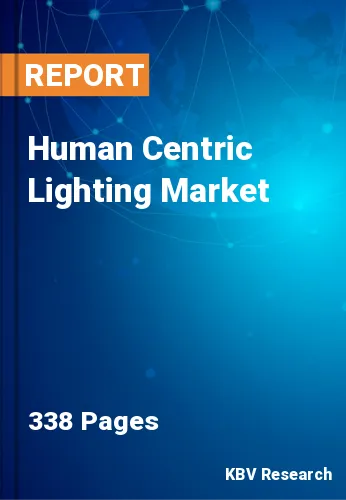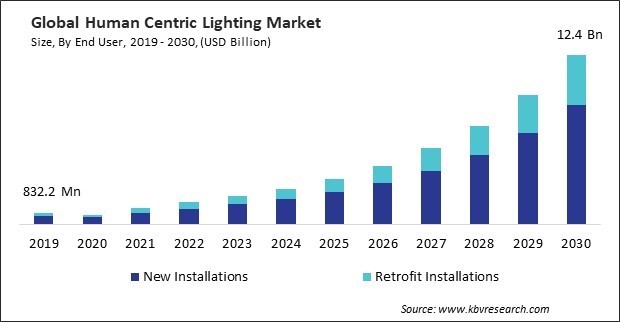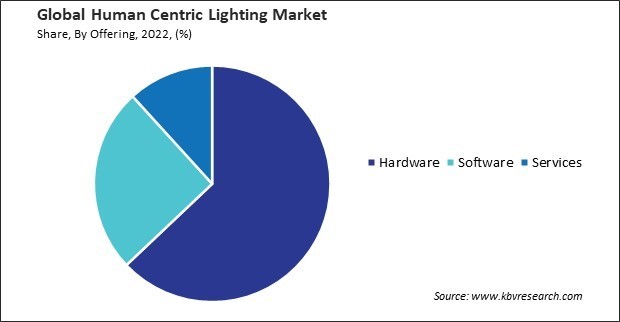
The Global Human Centric Lighting Market size is expected to reach $12.4 billion by 2030, rising at a market growth of 29.2% CAGR during the forecast period.
The incorporation of microprocessors and microcontrollers has allowed for the development of intelligent control systems within HCL solutions. Therefore, the microprocessors and microcontrollers segment captured $64.0 million revenue in the market in 2022. These systems enable precise adjustment of lighting parameters, including color temperature and intensity, based on various factors such as time of day, occupancy, and user preferences. This level of control is integral to delivering the tailored and dynamic lighting conditions associated with human-centric lighting.

Mimicking natural daylight helps align circadian rhythms, the body's internal clock that regulates sleep-wake cycles. Properly designed human-centric lighting considers factors such as glare reduction and optimal lighting conditions, which can help reduce eye strain and fatigue. This is particularly important in work and learning environments where individuals spend extended periods under artificial lighting. Thus, these aspects will increase demand in the market.
Additionally, HCL is incorporated into public spaces such as parks, streets, and squares. As per the data from the Statistics Canada, investment in building construction rose 1.7% to $19.8 billion in November 2023. Investing in the residential sector increased by 2.2% to $13.7 billion, whereas investment in the non-residential sector rose by 0.4% to $6.0 billion. Therefore, these aspects will pose lucrative growth prospects for the market.
However, implementing human-centric lighting involves purchasing specialized lighting fixtures, sensors, controls, and possibly additional infrastructure. The upfront investment can be substantial, especially for large-scale installations in commercial or industrial settings. The perceived high cost could discourage individuals from switching, especially if unaware of the potential long-term benefits. Hence, these factors will lead to reduced demand for human centric lighting.
 Drivers
Drivers  Restraints
Restraints  Opportunities
Opportunities  Challenges
Challenges On the basis of installation type, the market is divided into new installations and retrofit installations. The new installations segment recorded the 71.7% revenue share in the market in 2022. As awareness of the physiological and psychological impacts on human health grows, a heightened demand for new installations that leverage human-centric lighting principles is heightened.
Based on offering, the market is segmented into hardware, software, and services. In 2022, the software segment garnered a 25.32% revenue share in the market. Software solutions play a crucial role in delivering personalized lighting experiences. Customizing lighting settings based on individual preferences, tasks, or circadian needs enhances the user experience.

The hardware segment is bifurcated into fixtures and controllers. The fixtures segment recorded the 64.93% revenue share in the market in 2022. The integration of advanced technologies in lighting fixtures, such as smart controls, sensors, and connectivity features, can drive market growth. Fixtures that offer adaptability and customization options in terms of color temperature, intensity, and timing align with the principles of human-centric lighting, contributing to their popularity.
The controllers segment is segmented into sensors, drivers, microprocessors & microcontrollers, switches & dimmers, and transmitters & receivers. The sensors segment recorded the 27.44% revenue share in the market in 2022. Sensors enable HCL systems to gather real-time data on various factors, including occupancy, user preferences, and ambient light levels.
Based on application, the market is divided into enterprises, residential, industrial, healthcare, education, hospitality, and others. The healthcare segment procured the 33.86% revenue share in the market in 2022. Healthcare facilities are increasingly adopting patient-centric design principles, aiming to create environments that contribute positively to the well-being and recovery of patients.
Free Valuable Insights: Global Human Centric Lighting Market size to reach USD 12.4 Billion by 2030
By region, the market is segmented into North America, Europe, Asia Pacific, and LAMEA. The North America segment procured a 30.0% revenue share in the market in 2022. There has been a growing awareness of the benefits of human-centric lighting in North America. Businesses, educational institutions, healthcare facilities, and residential spaces have shown an increasing interest in implementing lighting solutions that positively impact human well-being and productivity.
| Report Attribute | Details |
|---|---|
| Market size value in 2022 | USD 1.6 Billion |
| Market size forecast in 2030 | USD 12.4 Billion |
| Base Year | 2022 |
| Historical Period | 2019 to 2021 |
| Forecast Period | 2023 to 2030 |
| Revenue Growth Rate | CAGR of 29.2% from 2023 to 2030 |
| Number of Pages | 338 |
| Number of Tables | 570 |
| Report coverage | Market Trends, Revenue Estimation and Forecast, Segmentation Analysis, Regional and Country Breakdown, Porter’s 5 Forces Analysis, Company Profiling, Companies Strategic Developments, SWOT Analysis, Winning Imperatives |
| Segments covered | Installation Type, Offering, Application, Region |
| Country scope |
|
| Companies Included | Signify N.V., ams-OSRAM AG, Acuity Brands, Inc., Cree, Inc. (SMART Global Holdings, Inc.), Legrand S.A. (Legrand Group), Hubbell Incorporated, Lutron Electronics Co., Inc., Zumtobel Group AG, Koninklijke Philips N.V., Wipro Limited |
By Installation Type
By Offering
By Application
By Geography
This Market size is expected to reach $12.4 billion by 2030.
Growing awareness of health and well-being are driving the Market in coming years, however, High initial costs of human centric lighting restraints the growth of the Market.
Signify N.V., ams-OSRAM AG, Acuity Brands, Inc., Cree, Inc. (SMART Global Holdings, Inc.), Legrand S.A. (Legrand Group), Hubbell Incorporated, Lutron Electronics Co., Inc., Zumtobel Group AG, Koninklijke Philips N.V., Wipro Limited
The expected CAGR of this Market is 29.2% from 2023 to 2030.
The Hardware segment is leading the Market by Offering in 2022; thereby, achieving a market value of $7.6 billion by 2030.
The Europe region dominated the Market by Region in 2022, and would continue to be a dominant market till 2030; thereby, achieving a market value of $4.4 billion by 2030.
Our team of dedicated experts can provide you with attractive expansion opportunities for your business.
